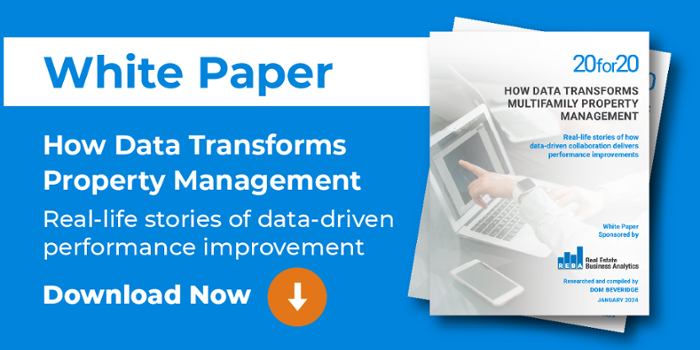
A new year is upon us - I hope my readers had the chance to relax a bit over the holiday period. As usual, the holidays provided some breathing space for reading, and one of my favorite holiday reads this year has been "How to Win the Premier League." It's a fascinating book about statistical analysis (stay with me) by Ian Graham that holds a couple of important lessons for multifamily.
The book is a first-hand account of the transformation of Liverpool Football Club in the English Premier League under the ownership of Fenway Sports Group (FSG). FSG were early adopters of Billy Beane's Moneyball model at the Boston Red Sox, famously ending the Curse of the Bambino in 2004. Liverpool's conversion from decades of under-performance to a dominant force in the league is largely attributable to their mastery of the emerging field of analytics.
Lessons for Multifamily
Reading the book reminded me of two crucial elements multifamily operators must understand as they approach data and analytics. The first is collaboration. A year ago, I published a paper about multifamily operators who have advanced significantly in business intelligence (BI). That research aimed to identify where the financial upside lies in improved analytical capabilities. The key finding was that all the financial gains were tied to new forms of collaboration that the analytics enabled.
The operators described three categories of collaboration: within or between teams in an organization, or between central functions and properties. The key to improvement in each case was the collaborators' ability to tailor metrics to the specific problem they were trying to solve. Turn times, for example, came down dramatically when revenue management and maintenance teams could custom-build metrics that tracked every step from NTV to make-ready. The statistics enable all parties to communicate in the same language and focus on the right things. Performance improvements usually follow.
A similar story unfolds in Ian Graham's book. The development of new and highly precise statistics to characterize soccer team performance—a process that involved many failures along the way—eventually led even the most skeptical sports experts to buy into a new way of working. This shift, though initially met with resistance, ultimately delivered sustained success. That brings us to the second indispensable factor in successful analytics programs: culture.
Purple People
Graham's book reminded me of a concept popularized years ago in our industry by my friends Chris Brust and Donald Davidoff: the idea that BI success depends on the presence of "purple people." Analytics programs typically depend heavily on both IT and business expertise. There is a natural, cultural divide between those groups, and an organization's ability to bridge the divide largely determines the success of analytical projects.
If IT people are red and business people are blue, it is the people with a deep appreciation of both domains—"purple people"—who make the biggest difference. When organizations find and develop purple people and deploy them on BI projects, chances of success go up substantially.
 Graham's book brings this theme to life through deep insights into highly consequential decisions like player trading. The red people worked to develop ever better statistical models to understand value in the market for new players. Liverpool's previous, ultimately unsuccessful coach was a classic blue person, whose emotional priors and experience would not give way to data-driven insight.
Graham's book brings this theme to life through deep insights into highly consequential decisions like player trading. The red people worked to develop ever better statistical models to understand value in the market for new players. Liverpool's previous, ultimately unsuccessful coach was a classic blue person, whose emotional priors and experience would not give way to data-driven insight.
The unresolved culture clash compromised the club's decision-making. The analytical team would horse-trade with the coach, sanctioning statistically risky decisions in exchange for permission to buy players that the statistics supported. As with many compromises, this one yielded bad decisions, and the team suffered with a suboptimal roster until the coach left.
That insight casts a new light on leadership. The coach who followed—Jürgen Klopp—was famous for his charisma, tactical excellence and previous success. However, perhaps his greatest contribution to Liverpool was creating an environment of collaboration where analytics, team development and coaching all spoke the same language. Despite having little experience with analytics, Klopp turned out to be a purple person, bridging the gap between those building data models and those making day-to-day decisions. This collaboration resulted in Liverpool out-performing the league in player trading and ending a multi-decade wait for a national title, repeating the owners' previous feat with the Red Sox.
"Culture eats strategy for breakfast."
Having worked as a consultant for many years, one quote (from Peter Drucker) in the book resonated with me more than anything else: "Culture eats strategy for breakfast." Anyone with extensive consulting experience knows how futile it is to push against an organization's culture. To succeed with analytics, achieving acceptance and driving good decisions requires resources capable of bridging cultural divides.
There are plenty of examples in multifamily where cultural biases clash with analytical logic. For one good example, see my previous post about how revenue management has suffered over the years due to vendors' habit of selling it as a competitor data tool. Over-indexing on competitor data plays well with the deal-side of multifamily (often the ones who sign the checks), but it misses the point of revenue management.
"How to Win the Premier League" was a welcome reminder of the relationship between data, organizational culture and performance. I highly recommend its entertaining and detail-rich account of how analytics can transform organizations, which I thoroughly enjoyed over the holidays.
Photo by Mike - via Pexels



